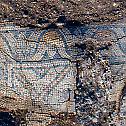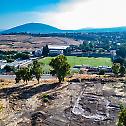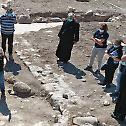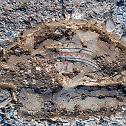Sixth-century Church Found by Circassian Village Near Mount Tabor
Move a rock in Israel, find an archaeological site. Now, ahead of building a playground for kiddies in the Circassian village of Kafr Kama, archaeologists conducting a “salvage excavation” have found the ruins of a 1,300-year-old church dating to the Byzantine period.
Actually, the excavators suspect the villagers carried out their devotions at a smaller local church with two chapels in the village dating to about the same time, which had been discovered half a century ago. The newly discovered, rather bigger edifice may have been a monastery, the archaeologists think, based on adjacent rooms that remain underground after being discovered by Shani Libbi using ground-penetrating radar.
Kafr Kama’s proximity to the iconic site of Mount Tabor – where some believe Jesus underwent the Transfiguration and began to radiate light – piqued the interest of Archbishop Youssef Matta, the head of the Greek Catholic Church in Israel. He was invited by the Israel Antiquities Authority, and came to see the site in person.
“And after six days Jesus taketh Peter, James, and John his brother, and bringeth them up into a high mountain apart; And was transfigured before them: and his face did shine as the sun, and his raiment was white as the light” – Matthew 17:1-2
The main body of the newly discovered church is 12 by 36 meters (39 by 118 feet), which is medium-sized for the region, says Prof. Moti Aviam of the Kinneret Academic College, who is researching the Byzantine period in the Galilee and is collaborating with the Israel Antiquities Authority on this dig.
The discovery of the church was not expected, said Nurit Feig, the archaeologist leading the excavation on behalf of the Israel Antiquities Authority. “This was a small salvage excavation that we expanded,” she told Haaretz. Usually, a salvage excavation of this sort is defined in scope, but then she began to see the border of the nave wall and an apse – and realized they were on top of an ancient church.
Now they know the area includes a courtyard, a narthex foyer, a central hall and three apses. Churches in the Galilee normally have one or three apses, Feig and Aviam explained.
Wondrously, the archaeologists also found a reliquary: a stone box used to hold “sacred relics.” Sad to relate, it was empty. “The other ancient church found in Kafr Kama also had a reliquary, a closed one, that had bones inside,” Aviam said.
“In light of our many studies in Israel in general and the Galilee in particular, we know there were a lot of village rural monasteries. The monks weren’t hermits like in the desert monasteries. They lived alongside the villages, sometimes inside the villages, with villagers working at the monastery,” Aviam said. He added that they have no proof this new discovery is actually a monastery – no inscriptions have been found, for instance. But that’s his gut feeling.
Nor is there evidence for how the monks made their living, if monks there were. It has been found that at other Galilean monasteries, the monks engaged mostly in agriculture, producing olive oil and wine, Aviam said.
Church or monastery, it had mosaics on the floor of the nave and apses, which is very much the norm for the Galilean churches. But they were badly damaged, Aviam said. All we can see are geometrical motifs and some flowers in blue, black and red, but there may have been other images that are now gone.
Faith in the Galilee
In fact, the two sixth-century churches of Kafr Kama fit the bigger picture that Aviam is discovering in his research of the Byzantine Galilee, conducted with Jacob Ashkenazi of the Kinneret Institute of Galilean Archaeology in the Kinneret Academic College.
In Western Galilee alone, there are about 100 churches from the Byzantine time, very roughly speaking, Aviam told Haaretz.
The western side of the Upper Galilee was actually Christianized in the Byzantine period while the eastern side was Jewish, he explained. Down in the lower Galilee, the towns were almost entirely Jewish, but Christianity gradually penetrated – resulting in villages like Kafr Kama, with its two churches. Or one church and one monastery. (We don’t know Kafr Kama’s ancient name, Aviam noted.)
The attraction for early Christians in the Galilee included the city of Nazareth: Jesus was reportedly born in Bethlehem, but grew up in the Galilee. Nazareth was actually mixed during the Byzantine period, Aviam said – Jewish with some churches.
Like so many places in the region, occupation in the town now known as Kafr Kama goes back to the Bronze Age, and possibly earlier. But we may never know (much) more about the Christian era in this village.
This very week, the mosaics are going to be re-blanketed in earth for the sake of their conservation, Feig told Haaretz. That will protect them for the future masses that will probably never see them. The site is earmarked for a playground, and unless the local council and Jewish National Fund change their minds, a playground it will be.
“We can’t say at this stage how much may be covered and if anything will be preserved,” Feig said. The IAA may warmly recommend that the site be conserved, preserved and opened for visitors; but the initiators of the real estate project in the village have the ultimate decision, she explained. And if they decide to preserve the ancient church or monastery, whichever it is, then the IAA experts can happily get to work.
The first church from early Christianity found in the Circassian village is also gone, partly covered, partly built over, the archaeologists say. Discovering the new one was an emotional moment for the excavators and villagers alike, who flocked to see it during the “open days” the archaeologists held – joined by the archbishop.
Asked why there was so much excitement if there are around 100 ancient churches in the Galilee, Feig said that this one is in a quite good state of preservation after all those 1,400 years: they know where all its parts are. But they may remain the only ones with that knowledge.
Source: Haaretz.com





